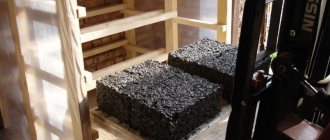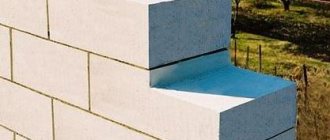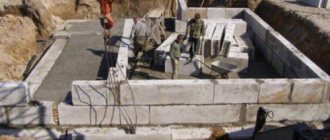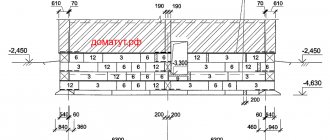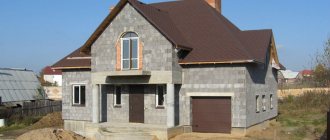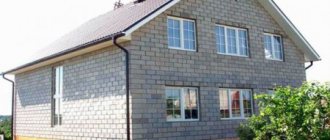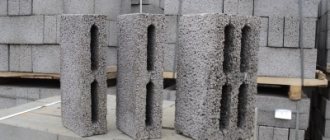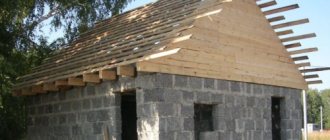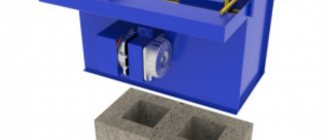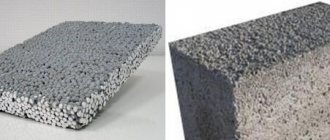Foundation blocks (FBS) are ready-made concrete or reinforced concrete products used for arranging the base of various buildings. They are used to lay out strip foundations for cellars, technical rooms, unheated buildings, basements and basements.
Many people call FBS foundation blocks wall or building, but in reality the decoding of the FBS abbreviation sounds like “solid foundation blocks.” The characteristic “solid” means that the blocks are made without voids. Along with FBS, there are FBP (hollow, with voids open downwards) and FBV (solid with a cutout for laying jumpers or laying communications under the ceiling of a technical underground or basement).
We advise you to study in more detail: “The most important things about aerated concrete: differences from foam concrete, secrets of cutting and calculation of volume.”
Marking of foundation blocks
Application area
Such foundations are in most cases used in private construction.
They do not have a high load-bearing capacity, which significantly limits their operational potential. On soils that are not prone to heaving, one-story houses, bathhouses, and buildings for household purposes are erected on a columnar foundation. If the construction is planned in an area with sandy, rocky or boulder soil, the load-bearing characteristics of the columnar foundation will be sufficient to build a full-fledged house from a log frame or a foam concrete block.
You should not build such a foundation in the following cases:
- erecting a large house with heavy walls;
- on soils with a low level of bearing capacity, in areas with moving soils;
- on sites with a natural height difference of more than a meter. In this case, it is necessary to plan the site.
On soil that is not prone to heaving or has low heaving, small frame, wooden or panel buildings can be erected on columnar foundations from blocks - one-story houses, bathhouses, utility rooms.
Rice. 1.2: Wooden house on a columnar foundation
If construction is carried out in a region with sandy, dense rock or coarse-grained (gravel, boulder and pebble) soils, the load-bearing characteristics of a columnar FBS foundation will be sufficient for the construction of full-fledged houses from logs, timber or foam concrete.
| Expert advice! A columnar foundation made of FBS blocks does not provide for the possibility of arranging a basement; if this criterion is important to you, pay attention to other types of foundations. |
The optimal depth for laying a columnar foundation made of FBS (and any prefabricated structures) is up to one meter; if construction conditions (type of soil, weight of the house) require a greater depth of laying, it is more rational to equip columnar foundations from asbestos-cement pipes filled with concrete, since laying FBS blocks to a depth of more than 1 meter is an extremely labor-intensive process.
It is not recommended to erect a columnar foundation made of FBS blocks in the following situations:
- During the construction of massive houses with walls made of heavy materials (brick, reinforced concrete wall blocks);
- On soils with low bearing capacity - clayey, subsidence, moisture-saturated;
- On moving soils, a columnar foundation has low resistance to horizontal displacement loads;
- On construction sites with a natural height difference of more than one meter (preliminary leveling of the ground is required).
Rice. 1.4: Foundation support pillars before grillage piping
Nuances of using FBS blocks
Let's start with the fact that there are certain prohibitions on the use of concrete foundation blocks. They need a solid foundation, for example, rock, or, in extreme cases, sand. True, modern technologies make it possible to install FBS even on moving soils. You just have to invest a lot of money to prepare the soil.
Usually, for this purpose, a monolithic reinforced concrete platform is formed in the form of a slab foundation. And then they build blocks on top of it with a reinforcing belt lining the second row. In fact, the result is a triple consumption - slab+blocks+reinforced strip foundation. Add a sand cushion under the entire slab, and the consumption increases.
There is cheaper technology. Based on it, an intermittent foundation is obtained. This is when blocks are installed with a gap, which is subsequently filled with soil. The latter must be compacted. But there are some prohibitions here too:
- the distance between blocks is no more than 70 cm;
- the foundation for them must be very strong with high load-bearing capacity.
Another option, which is used on soft soils, is the installation of FBS blocks with a thrust bearing. The latter is a type of foundation pad made using reinforced concrete technology. It is large in size, thus increasing the support area. And accordingly, reducing the pressure on weak soil. The photo below shows such thrust pads.
Bearings for FBS blocks Source st12.stpulscen.ru
Soil preparation
The use of FBS blocks requires compacted soil. Using FBS elements, you can easily make a strip or columnar block foundation with your own hands.
Each type of design has its own type of advantages. The construction of such a foundation for a residential building requires a construction site with a dense soil structure.
Construction experts recommend installation on such soils as:
- soil structure based on compacted sand;
- crushed stone or gravel;
- rock types.
Construction of a block foundation It is important to complete the geological stages of the work before making a foundation of blocks. They are necessary to determine the composition and density of soil layers at a construction site.
This work is done by drilling layers of soil to a certain depth, and then taking a sample for analysis.
In order to prevent deformations and cracks from forming on the roof structure and main walls after a certain period of time, soil tests must be carried out.
If the constructed type of foundation is placed on soils whose structure has unstable characteristics, then this problem can be solved by partially replacing the soil at the construction site, as well as compacting it.
Most often, for individual construction, in order to save money, soil samples are not taken to laboratories. They are carefully studied directly at the drilling site.
Block weight
The mass is affected by the type of concrete and the dimensions of the product. If you estimate the weight of blocks of the same length, then the range of indicators will be large.
Numbers to guide buyers:
- with a length of 238 cm, the blocks weigh 1–2 tons;
- if the length is 118 cm - 0.3–1 t;
- blocks 88 cm long have a mass of 350–700 kg.
The weight of the blocks depends on the types of concrete and the size of the product.
For loading, unloading, and installation, you will need construction lifting equipment.
Specifications
Typically, heavy concrete with a density of 1800-2400 kg/m³ is used for the manufacture of FBS. At the same time, depending on the category of the concrete mixture, the grade of concrete is determined. Eg:
- if the category is more than B7.5, then concrete grade M100 is used;
- B12.5 and above – M150;
- for heavy concrete: B3.5 – M50, B15 – M200.
The moisture resistance of blocks according to GOST should not be less than W2. FSB should easily withstand 50 cycles of freezing and defrosting. There is no need to talk about thermal conductivity qualities; it’s still pure concrete. And although manufacturers offer foundation blocks made of expanded clay concrete, the thermal insulation qualities still leave much to be desired.
Marking of the foundation blockSource st29.stpulscen.ru
Let's look at block labeling. For example, FBS-24-4-6 t. What the numbers mean are the sizes of the foundation blocks. That is, length 2380 mm, width – 400, height – 580. The letter “t” means that the product is made of heavy concrete. If silicate concrete was used, then the letter “c” would be placed at the end of the marking. If it was expanded clay concrete, then the letter “p”, that is, with a porous base.
Please note that the minimum weight of the foundation block is 260 kg. Even for this you will have to use heavy equipment. They are usually used to build foundations for lightweight structures. More often, standard products weighing 1960 kg are purchased for the construction of houses.
It is very important to consider the ratio of the mass of the block and its dimensions. For example, if the weight is below standard, then there is a high probability that there are voids inside the product that reduce the strength of the material
Or, during the process of pouring the concrete solution into the molds, the latter was poorly compacted.
Please note that manufacturers also offer other types of foundation blocks. The only difference in their markings is the alphabetic characters.
Eg:
- FBP are blocks that have hollow areas at the bottom.
- FBV are products that contain channels for laying communication networks.
By the way, the weight of FBS differs from the other two modifications.
Hollow foundation blocks - FBPI source stk-uspeh.ru
Recommendations for purchasing FBS
Before purchasing materials, it is necessary to accurately calculate the number of foundation blocks and their dimensions.
When purchasing, be sure to check that the weight of the foundation blocks corresponds to their dimensions according to the table above. In the case of a lower weight, we can conclude that insufficiently compacted concrete was used in production. Such a foundation will not be durable, and you should not buy such a product.
Buy only factory-made FBS boards. They undergo the necessary quality control. Homemade materials are fraught with a lot of unpleasant surprises.
In addition to FBS, factories also produce FBV boards. These are concrete blocks of different sizes with pre-prepared cutouts for laying communications.
What is FBS
So, what is FBS?
They are presented in the form of heavy concrete products, expanded clay and dense silicate varieties. The main purpose of concrete foundation blocks is the construction of prefabricated foundations, basement walls, and basement sections. It is recommended to purchase FBS concrete blocks if there is a need for the rapid construction of an underground structure, which, in its main characteristics and load-bearing capabilities, can be second only to monolithic reinforced concrete.
Concrete foundation blocks are intended for the construction of small objects; they are also used for the construction of multi-story structures. The foundation made of FBS perfectly withstands loads and guarantees that the house will be strong, even if certain mistakes are made during construction.
Foundation blocks are made from reinforced concrete. They are based on a concrete solution reinforced with steel reinforcement, which turns it into a reliable option for installation.
Standard FBS blocks differ in parallelepiped shapes. The main advantage is that a foundation made of concrete blocks is built much faster, and financial costs are reduced. As follows from numerous consumer reviews, foundation blocks allow you to evenly distribute the load on the base of the object and build strong and frost-resistant walls.
The procedure for laying FBS concrete blocks
In the case of dry sandstones, installation can be carried out directly on the ground. In other situations, a preliminary installation of a sand cushion is required, which plays the role of a leveling layer. To lay FBS, a bedding thickness of 15 cm will be sufficient.
FBS foundation diagram
Important! Do not lay concrete blocks on a base covered with snow or water.
FBS foundation concrete blocks laid :
- The blocks are pre-cleaned of contaminants and moistened with water.
- First, elements are installed at the corners of the foundation and at the points where the internal walls adjoin the perimeter of the building.
- Using a level, check the coincidence of the surface level of the upper planes of all blocks.
- After checking, a cord is pulled between the installed beacons, along which the intermediate structures are subsequently installed. At the points where utility networks pass through, gaps are left between the elements.
Installation is carried out with ligation of vertical seams. To do this, each next row is shifted by about 2/3 of the block or additional products are used. The vertical joints are filled with concrete mixture, compacting it with a bayonet shovel.
Helpful advice! To correct the position of the block at the installation site, you can use a regular crowbar.
Moving the FBS to the installation site
Advantages and disadvantages of FBS foundation
The use of concrete blocks for foundation construction has become widespread in industrial and civil construction. In terms of strength and durability, prefabricated foundations are not inferior to monolithic ones, however, along with the advantages, they have a number of significant disadvantages.
pros
The most significant advantages of FBS support structures include:
- standardization.
The dimensions and technical characteristics of foundation blocks are strictly regulated by GOST 13579-78. This eliminates differences in the geometry of the FBS and ensures equal strength of the supporting structure; - high quality products
. Automation of the production process, vibration pressing and steaming, combined with total control at all stages of production, ensure not only high strength, but also compliance of products with all the requirements of GOST 13579-78. - high pace of construction work
. When building a medium-sized private house, laying the base and basement walls, if a crane is available, can be completed in one to two days. Ordering a ready-made solution can further speed up the process; - ease of installation
. Laying FBS does not require special knowledge, only special equipment is needed. A wide range of sizes makes it possible to mount a support structure of any level of complexity. In addition, if the blocks are placed incorrectly, the structure can be dismantled; - possibility of carrying out construction work in any conditions
. The technological process for the production of FBS involves the introduction of special ingredients into the working mixture, making it possible to use the blocks at low temperatures and on soils with high acidity; - manufacturability of the installation process
. Mounting loops, grooves and standardization of dimensions allow for maximum ease of assembly of the supporting structure.
All these advantages allow, in the shortest possible time, regardless of the characteristics of the soil and climatic conditions, to install a foundation that is not inferior in strength and durability to a monolithic one.
Minuses
The following disadvantages limit the use of FBS:
- presence of seams.
Where the blocks are joined, waterproofing must be carried out, which increases the time required to complete the work and its cost; - need for thermal insulation
. If the building is operated at low temperatures, the base must be protected from freezing, otherwise condensation will appear on the inner surface; - high price of materials and work.
The total cost consists of the cost of the blocks, wages of workers and the cost of renting special equipment. As a result, the cost of a block support structure is significantly higher than a monolithic one; - special requirements for soil.
The best option for constructing FBS foundations is dry sandy soils. If groundwater comes close to the surface, high-quality waterproofing is required, which significantly increases the cost of work.
From the above it follows that before proceeding with the installation of a foundation made of FBS blocks, it is necessary to carefully calculate the cost of materials and work, and also take into account the geodetic features of the soil.
Advantages of foundation blocks
FBS foundation blocks manufactured according to have several advantages:
- Possibility of manufacturing with specified characteristics of frost and water resistance, as well as resistance to aggressive environments.
- Significant acceleration of installation work on the construction of the foundation. Laying the blocks is much faster than building formwork, pouring concrete mortar and waiting for the concrete to gain grade strength (28 days).
- High density of joining of individual blocks, achieved due to precise dimensions and special design of products with special recesses.
- The ability to immediately begin the next work after installing the foundation. This is also due to the fact that there is no need to wait for the concrete mixture to gain its strength.
- Savings due to avoiding the purchase of boards or OSB boards for formwork, anti-frost and plasticizing additives.
- Reliability due to factory production with strict laboratory control.
- Durability. If properly manufactured and installed, a FBS foundation can be used for 100 years or more.
- Standard sizes. They allow you to accurately determine the required number of elements for the construction of a specific object.
Advantages of block material
The main positive quality of the block is the presence of state standards. With their help, the production of blocks with the required parameters and technical characteristics is regulated:
- the strength indicator of factory-made material is guaranteed by a control system and an automated production process;
- the ratio of components and manufacturing technology are fully observed;
- the stone goes through all stages, starting from mixing the concrete mass and its molding with pressing on a vibrating machine until complete hardening, during which steaming is performed;
- prompt execution of construction work. With a crane, the foundation and basement can be erected within a few days. And if you order the solution ready-made, without wasting time, then the time frame is reduced even more;
- simplicity of the material and its universal qualities. Laying blocks does not require any specific skills. If something is done wrong, the foundation can always be dismantled and the problem fixed;
- Extensive product line of material sizes. This makes it possible to build an object of any configuration. If the need arises, the block can be split into pieces of the required size;
- if work is to be done in areas with unfavorable climatic conditions, or the soils are complex, then special components are introduced into the concrete solution that improve the quality of the material in terms of resistance to sudden temperature changes and the effects of an acidic environment;
- For ease of installation, grooves and mounting loops are provided on the blocks, taking into account the thickness of the seam.
Advantages of using FBS for the foundation
In some cases, using FBS for the foundation is much more convenient than pouring a monolithic foundation.
- The time is reduced - the poured concrete foundation hardens and gains strength in about 4 weeks.
- Standard sizes make it easy to calculate the required amount of this material.
- There are no costs for additional materials (formwork, reinforcement).
- You can select blocks of the desired size and with the required characteristics.
- Durability - with proper installation, manufacturers promise a service life of more than 100 years.
- FBS do not deform over time.
The disadvantages of such a foundation include the need to use equipment for transporting and installing blocks, this leads to an increase in the price of the foundation.
Work order
- The construction of a foundation from FBS blocks begins with design. At this stage, you should draw a diagram of the future foundation and calculate how many blocks of what size you will need.
- Then markings are carried out on the ground, according to which the fertile layer is removed and the soil is excavated. If you are planning a basement made of FBS, then you need to mark its perimeter. Markings are made using pegs and cords.
- After excavating the soil, the bottom of the trench is compacted.
- Under the strip foundation made of concrete blocks, drainage is poured, which includes crushed stone and sand. Compaction of drainage is best done with a vibrating plate.
- Then the waterproofing is laid. A double layer is required.
- Next comes the installation of foundation blocks-pillows (FL). They are placed in a strictly horizontal position. A building level is used in the work. The gaps between the blocks are filled with sand-cement mortar.
- Then the reinforcement is placed, which is covered on top with a layer of mortar (3 cm).
- The next stage is the installation of FBS blocks. The foundation blocks are laid in such a way that the seams do not match in any place. The minimum offset value is 40% of the height of the FBS block.
- If the block foundation for a house requires two or more rows of blocks, then an armored belt with mortar is laid on top. Bandaging FBS blocks is a prerequisite. Only such a design will have the necessary margin of strength and stability.
Areas of application of foundation blocks
The main purpose of the FBS is the construction of the foundation. Such structures can be used regardless of the type of soil, but, according to recommendations, there should not be too much moisture in the soil. There is no need to construct formwork for the blocks, and their strength is guaranteed by the factory technology of vibration and steaming of concrete. Lighter types of FBS can be used for the construction of fences.
Fencing made from FBS blocks
FBS strip foundation: features of installation of foundation blocks
The process of installing blocks under the foundation does not require special knowledge or special skills.
To obtain a good result, it is important to strictly follow the sequence of actions, which are carried out in three stages
The first stage is to calculate the number of elements required to build the foundation. To do this, the volume of the building is determined, the resulting value should be divided by the volume of one block. The second stage is to prepare the foundation. The blocks should be laid on a sand cushion 50-100 mm thick, previously leveled and compacted. The length and width of the base should be 25-30 cm larger than the dimensions of the planned building. Next, the site is divided along its axes using plumb lines and a level.
The final stage is the direct laying of FBS blocks using a lifting mechanism. Beacon blocks are pre-installed at corners, intersections and foundation lintels. A level is used to check the coincidence of the upper planes of the beacons, between which the cord should be pulled. The remaining elements of the first row are set according to it. According to the project, it is necessary to leave gaps between the blocks for the passage of utilities.
Even at the design stage, it is worth taking care of purchasing blocks with large lengths. Please note! Before installation, the blocks should be cleaned of possible contamination and moistened with water.
The geometry of the entire foundation will depend on the correct installation of the first row of blocks. The accuracy of laying is controlled by a level. Structural elements are corrected with a crowbar. The next row is built according to the principle of brickwork. A layer of cement mortar is provided between the rows, which is compacted with a bayonet shovel. The height of the foundation is usually 5 rows of products.
Note! Do not install blocks on a base covered with water or snow.
When constructing small structures on a summer cottage, you can use used foundation blocks measuring 400x600x200 mm. And the price per piece of the product will be only 300 rubles.
The arrangement of the foundation includes a set of measures, the correct implementation of which determines the speed and quality of laying FSB blocks.
The use of FBS blocks in the construction of foundations and other objects can significantly speed up the process. The correct choice of product size and adherence to the installation sequence will be the key to creating a strong, reliable and durable structure.
Calculation of the amount of FBS
To determine the required number of blocks, you must first calculate the strip foundation. To do this, loads from all overlying structures are collected, which the foundation will have to withstand and transfer to the ground. Depending on the calculated load-bearing capacity, the volume of the entire foundation that will be required for the selected object is determined. The calculation process also takes into account:
- wall thickness;
- floor slab thickness;
- soil stability.
Please note: when selecting, depending on the width of the walls, slight overhang is allowed. For example, for brick walls, overhangs of up to 40 mm on both sides are acceptable. For 640 mm walls, 600 mm blocks are suitable, and for 510 mm walls - 500 mm wide.
The nature of the soil is of particular importance in choosing the type of FBS. If it does not have sufficient stability, blocks of impressive size will be required. For example, on clayey soils, the most voluminous elements are used, and on coarse-clastic soils, a foundation can be made from small-sized structures.
We advise you to study in more detail : “Hollow-core floor slabs: weight, dimensions according to GOST and other technical characteristics, as well as types, markings and installation technology.”
For example, we can take that the foundation will be built from FBS12.5.6-T blocks. To determine their number, you must first calculate the volume of one element:
1.18 · 0.5 · 0.58 = 0.34 m3.
All that remains is to divide the volume of the entire foundation by the resulting volume of one block.
Please note: the strength of the foundation, the installation process, the amount of costs and the time to complete the zero cycle of work depend on the size of one element.
Having calculated the number of blocks, you can lay them out - unfold the base. It shows how they will be located according to the height of the foundation and the length of the walls being built. In the drawing, you should immediately think about the dressing, which is at least 25 cm. From the development, you can successfully determine the length of the blocks used. They must be laid out so that no significant releases are formed.
Helpful advice: it is optimal when there are no more than 5 elements per length of one wall.
Example of FBS layout plan
FBS layout in 3D
Installation of a foundation made of FBS blocks
What you will need for installation
You can assemble a strip foundation from blocks yourself. To work, you will need to prepare consumables and tools: • concrete mixer; • shovels (bayonet, shovel); • tamping; • construction wheelbarrow; • measuring devices (level, level, tape measure, ruler, pegs, cord); • hammer, chisel, trowel; • container for mixing the solution; • blocks; • sand, crushed stone, cement; • waterproofing (roofing felt or bitumen mastic). To lay heavy block elements you will need to use a crane. Some developers make do with a winch, but the installation process with its help is labor-intensive.
Preparatory work
Before carrying out construction work, the site is cleaned. Not only debris, but also the turfy part of the soil is removed from the surface. A cord is pulled over the installed pegs, which determines the parameters of the future building.
When digging a trench, it is important to consider its dimensions to ensure smooth installation of the blocks. The bottom of the pit or trench must be leveled horizontally
If the soil type is sandy, sand backfill is not necessary. In other cases, such a layer is needed. According to the parameters, the sand cushion should be 20 cm larger than the foundation on each side. Some developers install some kind of permanent formwork from wooden boards up to 10 cm high. After filling the form, the sand must be moistened and compacted. In case of weak soil, it is recommended to increase the area of the building base. To do this, the first row is laid with FL slabs. An alternative is to fill the tape with concrete mortar.
Laying FBS blocks
The blocks are laid first in the corners. All joints are filled with cement mortar. Gradually the masonry moves to the internal partitions. Each row is controlled by a level for horizontalness. When arranging block elements, the principle of brickwork is observed. The thickness of the seams should not exceed 2 cm. All joints are filled with mortar. Formwork and reinforcing mesh are installed on the top row and concrete with a thickness of at least 100 mm is poured. After drying, the outer and inner surfaces of the foundation are treated with bitumen mastic to increase moisture resistance. When constructing the base of a multi-story building, it is recommended to lay each row with reinforcing mesh or twisted reinforcement (10 mm). This will give strength to the entire structure.
Design features of FBS
Externally, the foundation blocks are a rectangular parallelepiped:
- With special figured recesses at the ends. These recesses are necessary to connect the products to each other after installation. The joints of the elements are filled with concrete after they are installed at the installation site.
- With mounting loops on the top surface. They are made from hot-rolled reinforcement with a diameter of 12 mm and attached to the FBS by welding or anchoring. The purpose of the hinges is the FBS hook for transportation to the installation site and loading and unloading operations.
What does FBS look like?
Concrete blocks are a type of exceptionally prefabricated building material. Concrete is selected taking into account the operating conditions of the future structure. Particularly important:
- humidity percentage;
- ambient temperature and its changes;
- level of mechanical loads.
Maximum strength is typical for concrete M200; for harsh conditions, M150 can be used, and for standard conditions – M100. Ready-made FBS can be unreinforced or reinforced (reinforced concrete). The latter are especially common because they have improved strength characteristics. In their manufacture, reinforcement made of steel grade A1 or A111 is used.
Please note: the standards allow the production of FBS without loops, so if necessary, you can order such a modification of the blocks.
Features of FBS production:
- The casting is made in a special mold, which allows the geometric dimensions to be accurately maintained.
- To ensure uniform distribution of the mixture throughout the mold, after pouring, compaction is carried out using deep vibrators.
- Upon completion, the concrete is steamed. Due to this, within 24 hours the concrete gains 70% of its strength, for which under standard conditions it would take several weeks.
Please note: steaming does not affect the quality of the resulting products.
Mold for making foundation blocks
Types of blocks according to GOST: FBS, FBP, FBV, FL and BF
For the construction of a technical underground, basement walls, installation of columnar and strip foundations, construction of walls of low structures, unheated buildings and other structures operating under systematic exposure to temperatures from +50 to -70 degrees, concrete blocks can be used, which, based on GOST 13579-78 There are three types: FBS, FBV and FBP. Products are made from silicate, heavy concrete or expanded clay concrete. Their density should not be less than 1800 kg/m³.
FBP - blocks with one- or two-sided voids for laying communications.
According to the transcript, FBS is a foundation wall block with a maximum safety margin. When manufacturing monolithic small elements, structural reinforcement is not used. Metal is used only for the manufacture of hinges for installation. In the production of dimensional blocks, longitudinal reinforcement rods are necessarily used, which increases the weight of the FBS.
FBV blocks, unlike the previous type, have a longitudinal section in the cavity of the product. It is intended for installation of engineering communications. The manufacturing process of such products is similar to the manufacturing method of the previous version. Here, concrete of at least grade M100 is used. However, in the construction of FBV blocks are used extremely rarely, therefore they are manufactured mainly to individual orders. Products are available in lengths of 880 mm, heights of 580 mm and widths of 400, 500 and 600 mm.
Foundation blocks do not have reinforcement with the exception of embedded mounting loops.
FBP blocks are hollow lightweight concrete products that have open square holes in the lower part of the element. Concrete grade M150 is used for production. Products are produced in lengths of 2380 mm. Other linear dimensions of foundation blocks and prices for products are in a wide range. FBP blocks are used to create foundations for industrial equipment or to construct internal basement walls.
As a base for a columnar or strip foundation FBS, trapezoidal-shaped products are used, which are marked FL. The parameters and dimensions of foundation pads are regulated by GOST 13580-85. The width of the products varies between 600-3200 mm. The height of the elements can be 300 or 500 mm. The last value corresponds to products with a width of 2000 mm. The length of the block is 780-2980 mm. The largest elements have dimensions of 2980x2000x500 and 1180x500x3200 mm, and the smallest are available in sizes 1180x600x300 mm.
For the construction of internal and external walls of structures of agricultural and industrial enterprises, reinforced concrete strip blocks BF made of heavy concrete are used, which are regulated by GOST 28737-90. All elements are divided into six varieties, which differ in their cross-sectional sizes.
Installation of a strip foundation made of trapezoidal blocks, which are marked as FL.
Pros and cons of FBS blocks
What are the advantages of a prefabricated block foundation over a monolithic one:
- there is no need to purchase formwork and reinforcement for the frame;
- after pouring the monolith, it takes time to harden and gain brand strength, which usually takes 28 days;
- the prefabricated foundation can be loaded immediately after its installation;
- knowing the dimensions of the FBS, you can easily calculate the required amount of material;
- variety of sizes and characteristics, you can save money by choosing them wisely;
- long service life - more than 100 years;
- high strength of the material; such foundations do not deform during operation.
As for the disadvantages, there is only one – the large weight of the product. Therefore, to assemble the foundation structure, it is necessary to use heavy equipment in the form of a forklift or a crane. Unfortunately, their services are not cheap, which increases the cost of the construction process.
Special equipment is used to install FBS blocks Source i.simpalsmedia.com
Organization of work and order of their implementation
To finally understand the pros and cons of a foundation made of foundation blocks, you need to know all the technological features of the work process.
It is believed that FBS blocks are best used in cases where monolithic construction is not possible or is undesirable for certain reasons, ranging from significant removal of concrete units and poor climatic conditions to the usual lack of preparedness of the consumer when faced with complex issues regarding the arrangement of formwork structures, reinforcement, filling.
At the same time, it is necessary to recall that a foundation made of blocks is built much faster and does not require significant labor costs. Only the technological features of arranging a prefabricated base for a house can be significantly higher than during concreting using a monolithic method.
It will be necessary to involve equipment for excavation work and a crane, perform laying calculations, and adhere to the order of work.
The general sequence of actions is as follows:
- in accordance with the design solution and the binding scheme, markings are carried out;
- the soil is removed to the freezing depth, the inclined walls of the pit are formed in accordance with the calculated collapse prism;
- a monolithic base is poured, a cushion or concrete base is installed;
- the blocks are laid in rows and connected with a mortar made from sand and cement. The rows are tied at the junctions and corner areas with reinforcing mesh;
- the foundation base is maintained until complete shrinkage;
- the reinforcing belt is poured, the ceiling of the first floor is arranged;
- walls are being built;
- the foundation base is covered with waterproofing material, an insulating layer is installed;
- backfilling with soil is carried out.
The list of events and sequence are changing. If the groundwater level is high, the construction site is first drained, but the drainage system is laid at the initial working stage or before backfilling.
Creating a plan and selecting blocks
The construction of a foundation from FBS blocks requires the use of some kind of lifting equipment, since even the smallest blocks cannot be moved on their own.
FBS blocks Why use FBS blocks
First you need to select the block size. It should be borne in mind that the larger the blocks, the stronger the finished foundation, since it will have fewer seams (of course, maximalism should be avoided here). Therefore, for our bathhouse (or other light structure) we choose blocks that are ideally suited to its expected dimensions.
Table. FBS block sizes.
| FBS blocks | Length | Width | Height | Weight |
| FBS-9-3-6t | 88 | 30 | 58 | 350 |
| FBS-9-4-6t | 88 | 40 | 58 | 470 |
| FBS-9-5-6t | 88 | 50 | 58 | 590 |
| FBS-9-6-6t | 88 | 60 | 58 | 700 |
| FBS-12-3-6t | 118 | 30 | 58 | 460 |
| FBS-12-4-3t | 118 | 40 | 28 | 310 |
| FBS-12-5-3t | 118 | 50 | 28 | 390 |
| FBS-12-5-6t | 118 | 50 | 58 | 790 |
| FBS-12-6-3t | 118 | 60 | 28 | 460 |
| FBS-12-6-6t | 118 | 60 | 58 | 960 |
| FBS-24-3-6t | 238 | 30 | 58 | 970 |
| FBS-24-4-6t | 238 | 40 | 58 | 1300 |
| FBS-24-5-6t | 238 | 50 | 58 | 1630 |
| FBS-24-6-6t | 238 | 60 | 58 | 1960 |
| FBS-12-4-6t | 118 | 40 | 58 | 640 |
Excerpt from GOST standardizing the dimensions of foundation blocks.
You can draw up a foundation construction plan on paper, but it is much easier to download a special computer program for design. With its help, you can easily calculate how many blocks will be required for the entire construction.
We carefully mark out the pattern of laying the blocks and bandaging them. Do not forget to mark the routes of communications and the holes for their installation.
Disadvantages of FBS blocks
Types of block foundations
It is recommended to choose it only for areas with dry and low-heaving soils. But in fact, with proper calculation, such a support can be installed for any house and on any soil. FBS blocks made of reinforced concrete were originally developed to speed up and simplify construction. They can withstand considerable loads, you just need to select them correctly.
This is what a block base looks like
Buildings can be erected on a block foundation using all known building materials. There are no restrictions here. But for the same house made of SIP panels, which is distinguished by its light weight, it is better to choose cheaper screw piles. But in general, building rules and regulations allow walls made of brick, foam blocks, timber and logs to be erected on the base in question. Everything is at the discretion of the cottage owner.
What are FBS blocks and their purpose?
Any abbreviation hides a certain concept behind a dry designation.
FBS, if we turn to the literal decoding, are foundation building blocks. Moreover, by default it is assumed that such marking means a reinforced concrete structure of a rectangular shape without any cavities inside, that is, solid. In simpler terms, such blocks are nothing more than brick, a building material familiar to many, but reinforced with a reinforcement frame. In addition to blocks of the correct shape, there are other products of this type that differ in configuration:
with vertical through holes, the designation of which will be different - FBP;
with openings for communications - FBV;
so-called “pillows”, which are designated as FL.
The manufacturer of such products can produce a block of the required dimensions upon request, that is, it is not necessary to design the foundation based on a standard size range. In addition to the abbreviation, the designation also contains numbers that encrypt information about the overall dimensions of the block.
Such products are very widely used in the construction of both multi-story, heavy buildings and in the construction of residential buildings. The high level of demand for this material is due to its strength, which in turn is ensured by the presence of a reinforcement cage inside the block. This material is very attractive for builders also because there are various possibilities for fastening blocks:
1. Use of cement mortar. The masonry is carried out according to the same rules as when constructing a brick wall.
That is, correct ligation of the seams is necessary, and it is also very important to correctly orient each subsequent element relative to those already installed
2. Use of a special adhesive dry mixture, which just needs to be diluted while maintaining the correct proportions. Of course, this option is less labor-intensive and does not require time and effort to mix the mortar, however, in terms of cost, such a solution will be an order of magnitude more expensive than if you use cement mortar to lay the blocks.
Classification of block types
Products differ in size, weight and strength, as well as in the presence or absence of voids for electrical wiring and other communications. In the latter case, the designation “FBP” is used. As a rule, reinforcement is not added to the solution at the production stage, without which the resistance to loads is noticeably reduced. The fittings are installed to order in the factory, however, these measures are not always required, but only when the building’s load-bearing structures are of great height and thickness.
Three types of concrete are used as materials: heavy, silicate and expanded clay with corresponding densities of 2400, 200 and 1800 kg/m3. Resistance to distributed vertical loads depends on this parameter. These three types are displayed in the labeling with three capital letters: “T” - heavy; “P” - on porous fillers, that is, expanded clay; "C" - silicate.
The compressive strength class is indicated in the table
| Class | Average strength, kgf/cm² | Solution |
| B3.5 | 45,8 | M50 |
| B7.5 | 98,2 | M100 |
| B12.5 | 163,7 | M150 |
| B15 | 196,5 | M200 |
The sizes of FBS blocks for foundations vary widely. Along with the class, weight and type of material, they are displayed in the designation of products according to GOST.
Frost resistance exceeds 50 freezing and thawing cycles. If we take into account that the inside of the structure can be constantly in contact with warm air, which prevents it from freezing, the service life becomes significantly longer than that of the most reliable standard buildings.
Water resistance W2 will reliably protect against moisture if the masonry mortar does not fail, and if the design calculations are completed without errors.
All products are equipped with mounting loops necessary so that they can be picked up by a crane. When installed, they bend easily and do not create any problems, but production is possible without them.
Current regulations allow non-standard sizes and weights.
Manufacturing technology
FBS blocks are manufactured strictly in accordance with GOST at specialized enterprises from:
- heavy concrete with an average density of 2400 kg/m³;
- expanded clay concrete (1800 kg/m³);
- silicate concrete (2000 kg/m³).
For the first two materials, the standardized class for compressive strength is B7.5, for the last - B15. In production, cement of a grade not lower than M100 is used (many manufacturers prefer M200).
To produce FBS blocks, special collapsible metal molds are used.
The technological process looks like this:
- Before pouring concrete, all walls are lubricated with a special compound (to prevent the solution from sticking to the form).
- Then this container is filled with the prepared solution.
- Next, the concrete is compacted using submersible vibrators.
- Metal transport loops are installed in the solution that has not yet hardened.
- After the concrete gains primary strength, the mold is disassembled and the manufactured block is left for final drying.
For information! In the manufacture of FBS blocks, internal reinforcement is not used. Hence the name: solid, that is, the block consists of monolithic concrete without reinforcement with additional metal elements.
Modern technologies make it possible to speed up the production of FBS blocks without losing the quality and reliability of the manufactured products. Currently, specialized enterprises use automated universal installations for molding and vibrating compaction of blocks. To make blocks, a special (so-called semi-dry) concrete solution (based on M200 cement) is used.
What is such a foundation?
Foundations made of reinforced concrete blocks have a prefabricated structure.
They are created by laying ready-made FBS blocks, between which a layer of cement mortar is applied. Products are available in various sizes:
- thickness can vary between 200-600 mm in increments of 100 mm;
- standard lengths are 880, 1180, 1780 and 2380 mm;
- The height of FBS blocks ranges from 280 to 580 mm.
Prefabricated foundation structures made using this material are universal. They can be erected on various types of soil: rocky, sandy, clayey.
Important! If work is carried out on loose and unstable soils, a reinforced concrete base is additionally laid under the foundation, which increases the base area and allows the load to be more evenly distributed over the soil surface.
Development of the pit.
1. Random sampling of soil when developing a pit or trench in certain places must be filled with the same soil, brought to natural density. 2. In order to prevent the foundation soil from being eroded, softening and reducing its bearing capacity, before the construction of the foundations, work must be carried out to drain surface and groundwater from the pit (open drainage or drainage, water lowering, etc.). 3. As a rule, a break between the completion of the pit development and the installation of the foundation is not allowed. During forced breaks, measures must be taken to preserve the natural properties of the foundation soil.
Preparation
First, markings are made using pegs and ropes
At this stage, it is important that all dimensions are accurately transferred to the terrain and that the angles are right. Next, remove the fertile layer of soil and dig a trench or pit, depending on whether the house will have a basement
If there is a shallow strip foundation, then the depth of the trench should be 30-50 cm. If the foundation is deep, then the trench must be dug 40 cm below the soil freezing level.
Next, make a cushion of 15 cm of sand and 15 cm of crushed stone. They are compacted layer by layer using a vibrating rammer. To speed up the work, the sand is wetted. The pillow should be 30 cm wider than the foundation.
It is advisable to pour a concrete pad onto the sand base. In practice, when building with your own hands, this is rarely done. However, the base in the form of a concrete pad helps to properly distribute the weight. If you place FBS directly on the sand, then gradually gaps may form between them, which is undesirable. It is mandatory to make a concrete pad for houses with more than 1 floor.
To fill the reinforcing belt, formwork is built from edged boards, and the belt is reinforced. Then concrete is poured into the formwork and left to harden for 2 weeks, covered with sawdust.
It is not necessary to pour a concrete pad if cushion blocks are used. Then a masonry mesh is placed on the sand. Pillow blocks can be laid periodically, with intervals located under the blocks of the next row. The gaps are filled with sand. This allows you to save the amount of material, but on soil with good bearing capacity.

